Jiaxi Wu
COVID-19 Vaccine Misinformation in Middle Income Countries
Nov 30, 2023



Abstract:This paper introduces a multilingual dataset of COVID-19 vaccine misinformation, consisting of annotated tweets from three middle-income countries: Brazil, Indonesia, and Nigeria. The expertly curated dataset includes annotations for 5,952 tweets, assessing their relevance to COVID-19 vaccines, presence of misinformation, and the themes of the misinformation. To address challenges posed by domain specificity, the low-resource setting, and data imbalance, we adopt two approaches for developing COVID-19 vaccine misinformation detection models: domain-specific pre-training and text augmentation using a large language model. Our best misinformation detection models demonstrate improvements ranging from 2.7 to 15.9 percentage points in macro F1-score compared to the baseline models. Additionally, we apply our misinformation detection models in a large-scale study of 19 million unlabeled tweets from the three countries between 2020 and 2022, showcasing the practical application of our dataset and models for detecting and analyzing vaccine misinformation in multiple countries and languages. Our analysis indicates that percentage changes in the number of new COVID-19 cases are positively associated with COVID-19 vaccine misinformation rates in a staggered manner for Brazil and Indonesia, and there are significant positive associations between the misinformation rates across the three countries.
Cross Domain Object Detection by Target-Perceived Dual Branch Distillation
May 03, 2022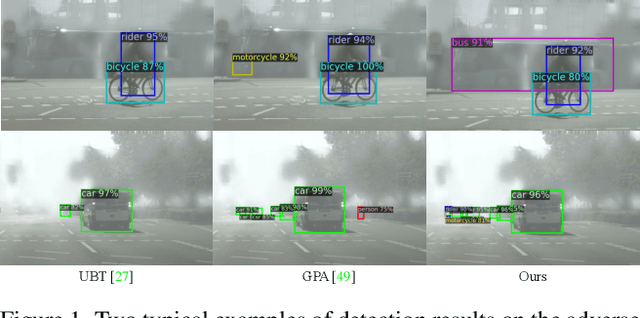
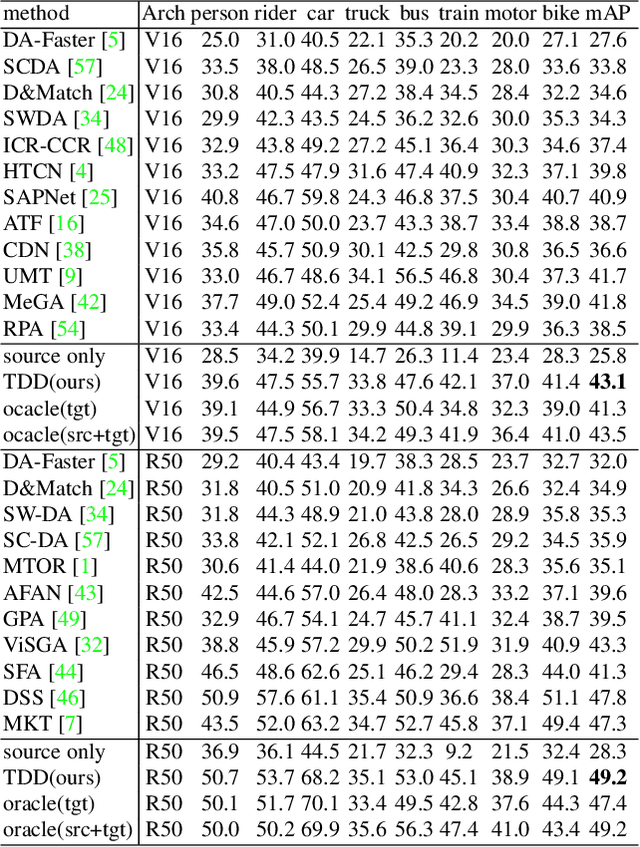
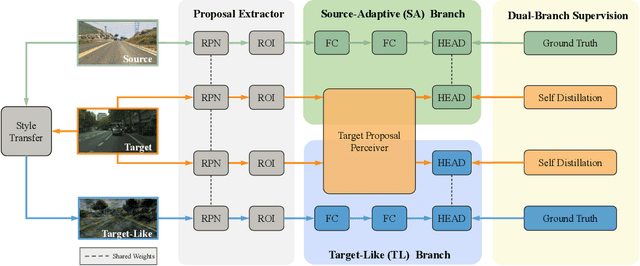
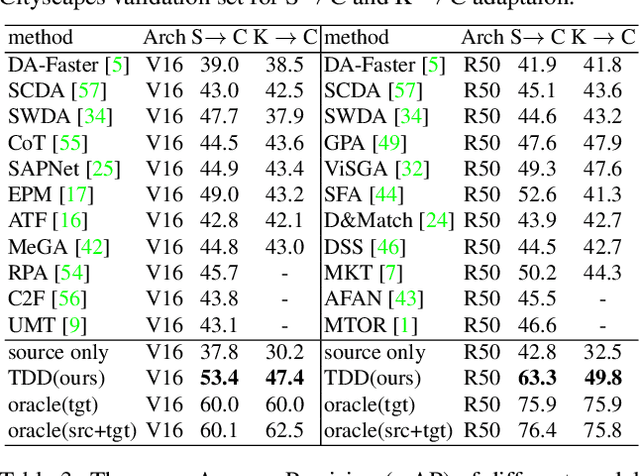
Abstract:Cross domain object detection is a realistic and challenging task in the wild. It suffers from performance degradation due to large shift of data distributions and lack of instance-level annotations in the target domain. Existing approaches mainly focus on either of these two difficulties, even though they are closely coupled in cross domain object detection. To solve this problem, we propose a novel Target-perceived Dual-branch Distillation (TDD) framework. By integrating detection branches of both source and target domains in a unified teacher-student learning scheme, it can reduce domain shift and generate reliable supervision effectively. In particular, we first introduce a distinct Target Proposal Perceiver between two domains. It can adaptively enhance source detector to perceive objects in a target image, by leveraging target proposal contexts from iterative cross-attention. Afterwards, we design a concise Dual Branch Self Distillation strategy for model training, which can progressively integrate complementary object knowledge from different domains via self-distillation in two branches. Finally, we conduct extensive experiments on a number of widely-used scenarios in cross domain object detection. The results show that our TDD significantly outperforms the state-of-the-art methods on all the benchmarks. Our code and model will be available at https://github.com/Feobi1999/TDD.
Entropy-based Active Learning for Object Detection with Progressive Diversity Constraint
Apr 17, 2022



Abstract:Active learning is a promising alternative to alleviate the issue of high annotation cost in the computer vision tasks by consciously selecting more informative samples to label. Active learning for object detection is more challenging and existing efforts on it are relatively rare. In this paper, we propose a novel hybrid approach to address this problem, where the instance-level uncertainty and diversity are jointly considered in a bottom-up manner. To balance the computational complexity, the proposed approach is designed as a two-stage procedure. At the first stage, an Entropy-based Non-Maximum Suppression (ENMS) is presented to estimate the uncertainty of every image, which performs NMS according to the entropy in the feature space to remove predictions with redundant information gains. At the second stage, a diverse prototype (DivProto) strategy is explored to ensure the diversity across images by progressively converting it into the intra-class and inter-class diversities of the entropy-based class-specific prototypes. Extensive experiments are conducted on MS COCO and Pascal VOC, and the proposed approach achieves state of the art results and significantly outperforms the other counterparts, highlighting its superiority.
Target-Relevant Knowledge Preservation for Multi-Source Domain Adaptive Object Detection
Apr 17, 2022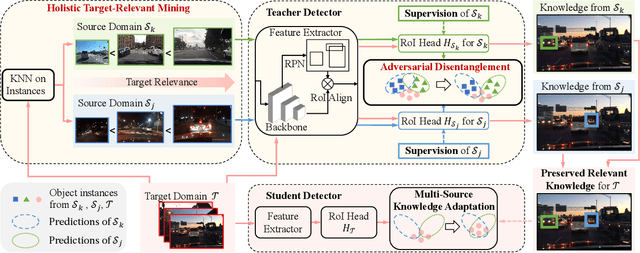
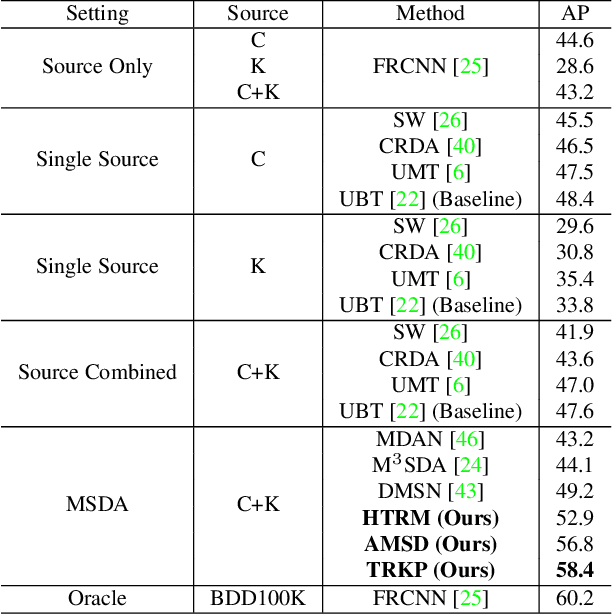

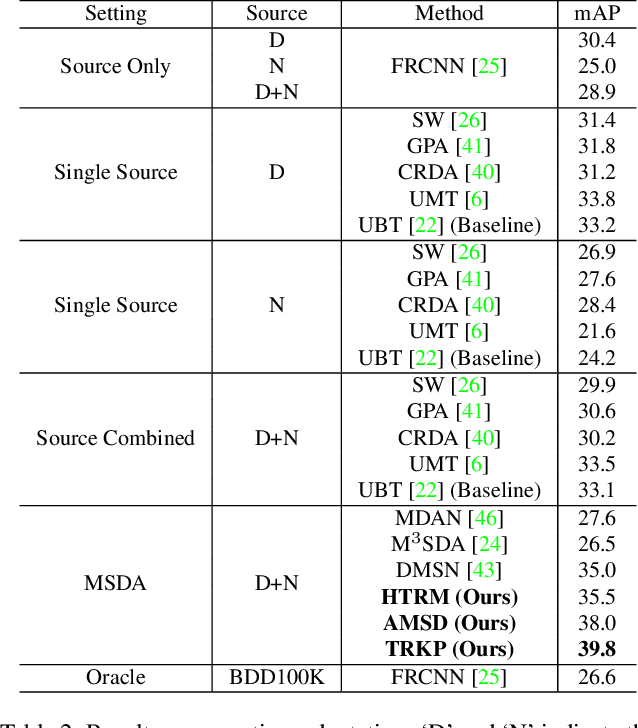
Abstract:Domain adaptive object detection (DAOD) is a promising way to alleviate performance drop of detectors in new scenes. Albeit great effort made in single source domain adaptation, a more generalized task with multiple source domains remains not being well explored, due to knowledge degradation during their combination. To address this issue, we propose a novel approach, namely target-relevant knowledge preservation (TRKP), to unsupervised multi-source DAOD. Specifically, TRKP adopts the teacher-student framework, where the multi-head teacher network is built to extract knowledge from labeled source domains and guide the student network to learn detectors in unlabeled target domain. The teacher network is further equipped with an adversarial multi-source disentanglement (AMSD) module to preserve source domain-specific knowledge and simultaneously perform cross-domain alignment. Besides, a holistic target-relevant mining (HTRM) scheme is developed to re-weight the source images according to the source-target relevance. By this means, the teacher network is enforced to capture target-relevant knowledge, thus benefiting decreasing domain shift when mentoring object detection in the target domain. Extensive experiments are conducted on various widely used benchmarks with new state-of-the-art scores reported, highlighting the effectiveness.
Multi-Scale Positive Sample Refinement for Few-Shot Object Detection
Jul 18, 2020


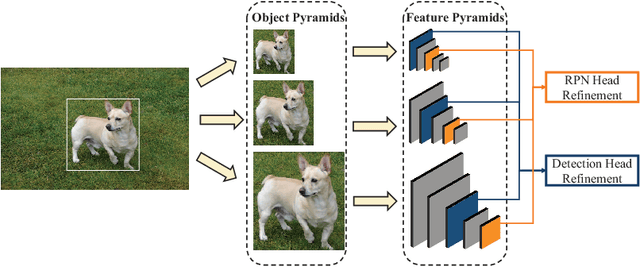
Abstract:Few-shot object detection (FSOD) helps detectors adapt to unseen classes with few training instances, and is useful when manual annotation is time-consuming or data acquisition is limited. Unlike previous attempts that exploit few-shot classification techniques to facilitate FSOD, this work highlights the necessity of handling the problem of scale variations, which is challenging due to the unique sample distribution. To this end, we propose a Multi-scale Positive Sample Refinement (MPSR) approach to enrich object scales in FSOD. It generates multi-scale positive samples as object pyramids and refines the prediction at various scales. We demonstrate its advantage by integrating it as an auxiliary branch to the popular architecture of Faster R-CNN with FPN, delivering a strong FSOD solution. Several experiments are conducted on PASCAL VOC and MS COCO, and the proposed approach achieves state of the art results and significantly outperforms other counterparts, which shows its effectiveness. Code is available at https://github.com/jiaxi-wu/MPSR.
 Add to Chrome
Add to Chrome Add to Firefox
Add to Firefox Add to Edge
Add to Edge